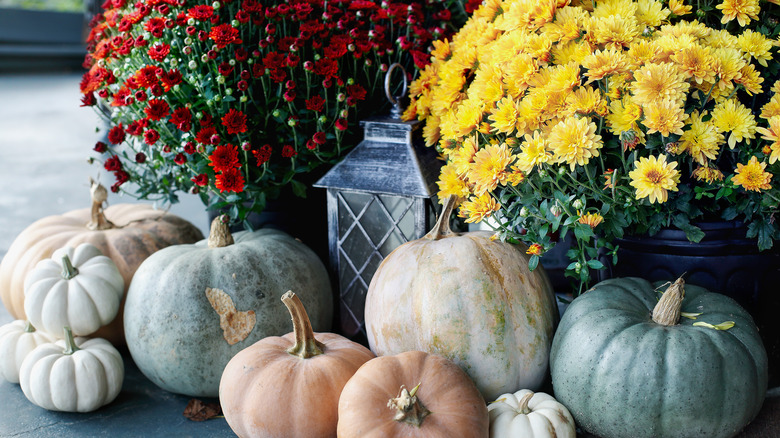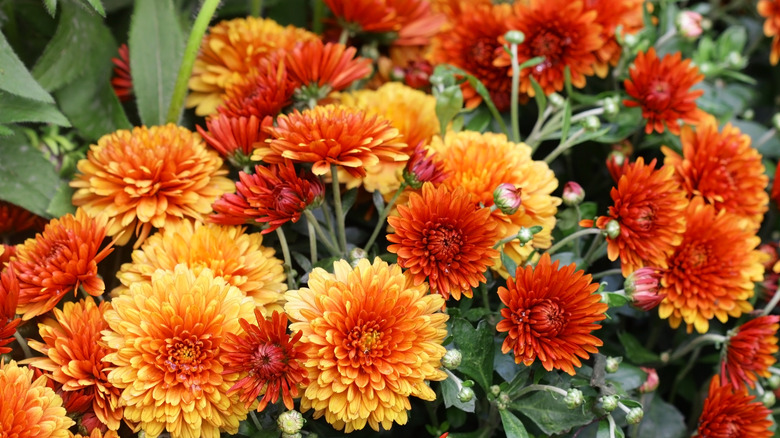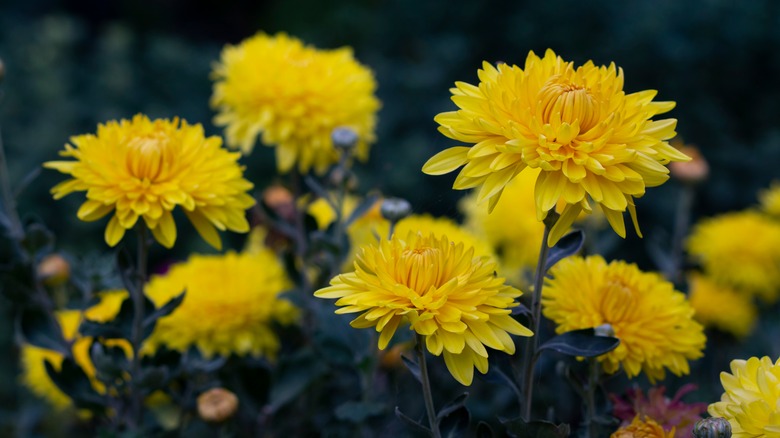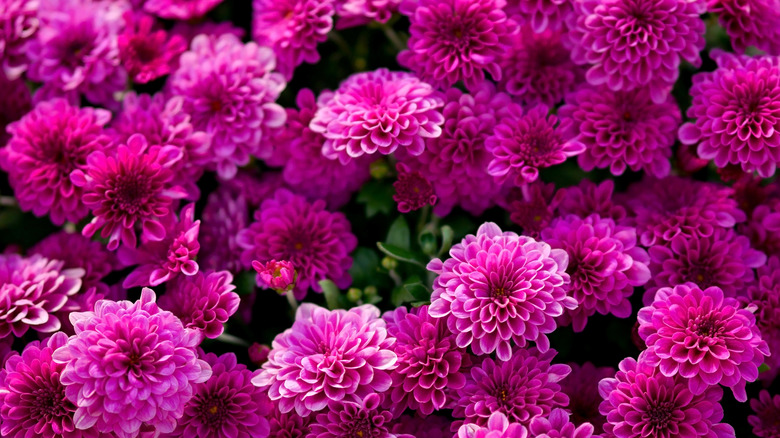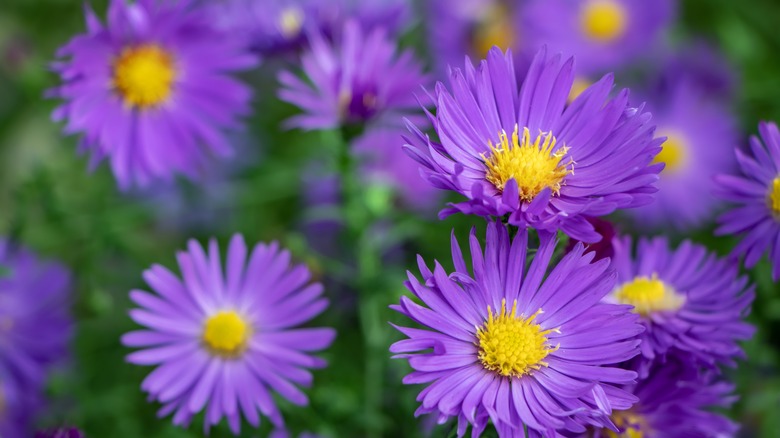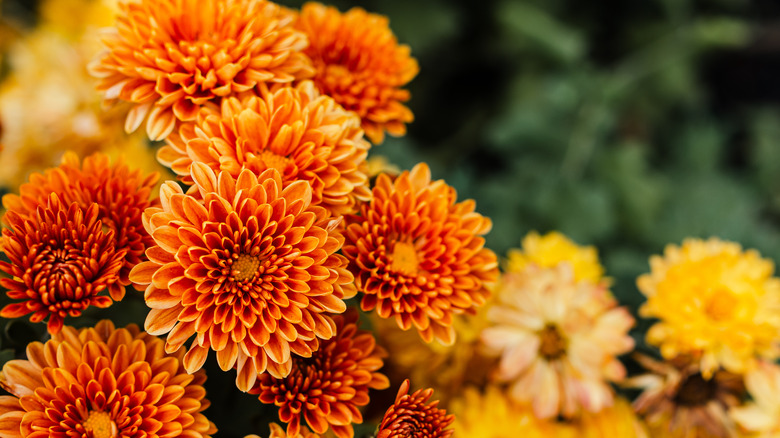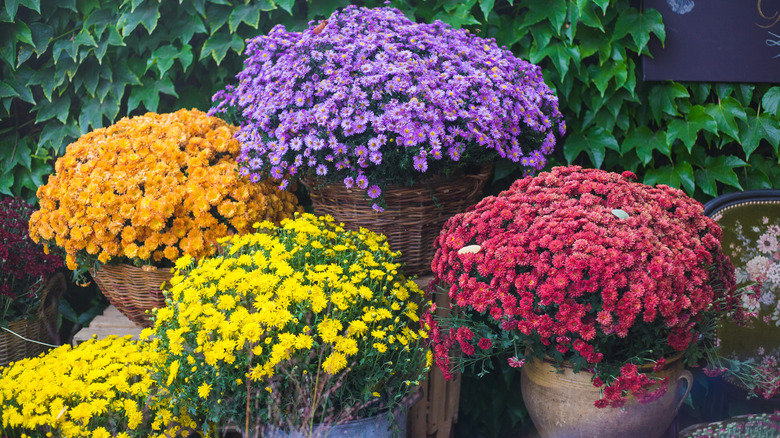How To Get The Most Out Of Your Fall Mums
Very few sights get us excited for fall quite like the brightly colored displays of chrysanthemums. Chrysanthemum spp., or mums for short, are the perfect reminder that your garden's colorful, floral beauty doesn't end when summer does. The uniqueness of mums doesn't stand in a single trait, as the way you use them can vary just as drastically. Mums come in both perennial and annual varieties, and both are equally beautiful. Garden mums, or hardy mums, are perennial plants that are planted outside, per Better Homes & Gardens. As the name suggests, they are hardy enough to survive cold temperatures and growing conditions and will continue to thrive in your garden year after year if taken care of.
Florist mums, also known as cutting mums, are annual plants. They are equally as beautiful but not hardy enough to survive cold winters outdoors like their perennial counterparts. They are typically used as container plants or as short-term plants in garden beds for temporary displays of color, which are then removed or die off when the flowers are spent and cooler temperatures arrive. Whether you choose to keep a garden or florist mum, properly planting and caring for your plant will ensure you get the most out of it for the season or year, depending on the type of mums you choose.
How to use mums in garden
Mums are the perfect addition to any flower bed in need of a refreshing pop of color for the fall season. Better Homes & Gardens suggests utilizing no more than two different colors of mums in your garden to make the most dramatic impact from far away. They also suggest planting a gradual transition of color shades to create an ombre effect if you are someone who has difficulty narrowing your choices down to just two colors.
Landscape plants are great to use behind groupings of mums, as the green backdrop can help the colors stand out more. This is an excellent option to explore incorporating bolder colored mum, such as bright pinks, purples, reds, and whites. Better Homes & Gardens suggests utilizing ornamental grasses, berry shrubs, sedum, or any conifer plant to mix in texture with your mums. If you incorporate other fall decorations into your garden, such as pumpkins and gourds, plant mums in color groupings that will coordinate well with the color scheme of the pumpkins and gourds, such as orange, bronze, and yellow, or white.
How to grow mums
According to HGTV, you should plant garden mums in the early spring; however, if you plant them in the fall, do it at least six weeks before the first frost to give them the best chance of surviving the winter and returning the following year. This will also give them time to establish a solid root system, making them hardy and giving them a better prospect of withstanding the cold. Florist mums can be planted in late summer or early fall, depending on when you are ready to refresh your garden with a pop of color. Mums thrive in full sun, and Home For The Harvest suggests planting them in an area where they will receive at least six hours of direct sunlight every day. This will ensure your mums are strong and have plenty of floral blooms.
Though Better Homes & Gardens warns against putting them out too early in the season, potted mums are no different, as the summer heat can dry your plant out if not watered daily. Home For The Harvest recommends planting your mums in moist, well-draining soil. Dry soil can make it difficult for your mums to establish a root system, preventing your perennial plants from returning the following year. On the other hand, soil that is too wet can saturate the roots and prevent your flowers from blooming. The soil should be consistently moist without becoming muddy. If puddles form on the surface without absorbing, it is likely too wet.
How to care for mums
Garden mums need to be regularly watered throughout the spring, summer, and fall, according to Home For the Harvest. You can stop watering once the ground freezes for the winter and resume when temperatures warm up again and the ground thaws. When watering, focus on the base of the plant, as the thick foliage and blooms on your mums can prevent the necessary amount of water from reaching the roots.
Deadheading your mums in the fall once the blooms disappear is an integral part of maintenance, but the rest of the plant, including the stems, should be left alone until the spring. Keeping the stems longer will extend bloom time every year. In the spring, you can cut your stems down to around 1 inch, which will allow the proper nutrients to reach the roots and keep your mums coming back year after year. Regular watering of both garden and florist mums will prevent them from looking stringy and allow an ample amount of flowers to bloom. In addition, daily watering may be necessary for particularly hot conditions to prevent your plant from drying out.
Mum varieties
According to Flower Glossary, there are approximately 20,000 species and 100 different cultivars in the United States of both garden and florist mums, with each being able to be categorized into one of the following categories:
- Incurved mums (Chrysanthemum × morifolium ′Luxor′) — This variety has thick florets that curve inward, giving them a fluffy appearance. They range from 6 to 8 inches in height and come in various colors.
- Reflexed mums (Chrysanthemum 'Venice) — This variety has globe-like blooms and ranges from about 4 to 5 inches in height. They most often come in red or orange shades.
- Anemone mums ( Chrysanthemum × morifolium ′Vernal Falls′) — Having the closest appearance to a daisy, this variety carries a central disc surrounded by long, tubular florets.
- Pom Pom mums (Dendranthema x grandiflorum) — This variety forms a globe-like bloom and grows to be 1 to 4 inches in diameter.
- Spider mums (Chrysanthemum x morifolium or C. morifolium) — This variety has tubular spiky florets that stretch out in all directions, resembling spider legs.
- Spoon mums (Chrysanthemum x morifolium) — The florets on this variety have a spoon-like curve at the end with a flat center disc.
- Quill mums (Chrysanthemum x morifolium 'Yellow Quill') — This variety features long, spiky florets that transition from a slight spoon shape to a downward curve, resembling a quill.
Are mums toxic?
Though mums are not dangerous to humans, ASPCA notes mums as being toxic to dogs, cats, and horses. The most common symptoms of mum poisoning in animals are hypersalivation, lack of coordination, and dermatitis. The severity of illness from mum poisoning depends on how much of the plant was consumed, and symptoms can appear suddenly or take up to 24 hours to appear, according to Wag!.
The toxins in mums can cause low blood pressure, respiratory failure, coma, and even death in severe cases if not treated right away, which is why it is so important to take your pet to the vet if you suspect they may have gotten into your mums. Also, always keep a close eye on your pet if they have access to the area where you grow your mums. If possible, plant them far away from little paws to avoid any kind of issue.
How to repot mums
Both florist and garden mums make excellent container plants. However, when specifically selecting mum plants to use in a container, look for plants with more buds than open blooms, per Better Homes & Gardens. This will allow your plant to last longer and give it the best chance of survival after repotting.
Always repot a purchased potted mum plant as soon as you get it home. Most mums kept in containers for long periods will become root-bound and develop very compacted root balls. Gently breaking up the root ball with your hands and planting it in fresh potting soil will ensure your annual plant thrives long enough to enjoy it for a full season. This will also assure you that your perennial plant is well taken care of enough to where there aren't any issues when you replant it in your garden. The roots of mums need room to breathe, so repotting is always a good idea, whether you are growing a garden or florist variety.
